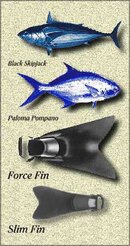So, each student came up to the cave with 2 pairs of fins, just in case?

Seriously, I am trying to get some answers here, not just the usual mantra "paddle fins are go-o-o-o-od, split fins are ba-a-a-a-ad!"
I already compared fins with kayak paddles. Why are paddles rigid but fins flexible? And not only splits are flexible, 95% of all fins you see are flexible here or there, like Mares X-Stream or Scubapro Seawing Nova that flex in the middle. If fins must be rigid too, why not make fins of aluminum alloy? In fact, I've seen such fins but I have no idea how good they are.
Now look at the fish. Tuna and marlin are the fastest fish of them all, and their tail fins look pretty much like split fins to me, only the blades are spread wider. I am sure that after 400 million years of evolution fish could have come up with a rigid bone tail fin instead, if this had any mechanical advantage. Yet I do not know any fish that uses a bone plate as a tail fin and the fastest fish prefer splits. Why is that?
I can see just one difference with a kayak paddle. The paddle moves in the water one way, while fish tails and diver's fins move back and forth. What difference does it make?





